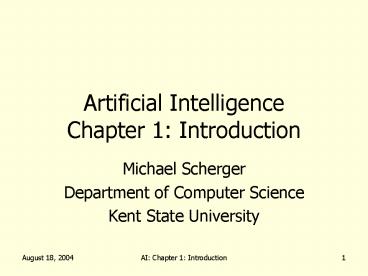Artificial Intelligence Chapter 1: Introduction - PowerPoint PPT Presentation
1 / 22
Title:
Artificial Intelligence Chapter 1: Introduction
Description:
'The art of creating machines that perform functions that require intelligence ... Diagnosing diseases. Translating languages. Data mining. August 18, 2004 ... – PowerPoint PPT presentation
Number of Views:67
Avg rating:3.0/5.0
Title: Artificial Intelligence Chapter 1: Introduction
1
Artificial IntelligenceChapter 1 Introduction
- Michael Scherger
- Department of Computer Science
- Kent State University
2
A Bit of Humor
3
What is Artificial Intelligence?
- Systems that think like humans
- The automation of activities that we associate
with human thinking... - Bellman 1978
- Systems that act like humans
- The art of creating machines that perform
functions that require intelligence when
performed by people - Kurzweil 1990
- Systems that think rationally
- The study of mental faculties through the use of
computational models - Charniak and McDermott
- Systems that act rationally
- The branch of CS that is concerned with the
automation of intelligent behavior - Lugar and Stubblefield
4
Acting Humanly
- The Turing Test (1950)
- Can machines think?
- Can machines behave intelligently?
- Operational test for intelligent behavior
- The Imitation Game
Human
?
Human Interrogator
AI System
5
Acting Humanly
- Turing Test (cont)
- Predicted that by 2000, a machine might have a
30 chance of fooling a lay person for 5 minutes - Anticipated all major arguments against AI in
following 50 years - Suggested major components of AI knowledge,
reasoning, language understanding, learning - Problem!
- The turning test is not reproducible,
constructive, or amenable to mathematical analysis
6
Thinking Humanly
- 1960s cognitive revolution
- Requires scientific theories of internal
activities of the brain - What level of abstraction? Knowledge or
Circuits - How to validate?
- Predicting and testing behavior of human subjects
(top-down) - Direct identification from neurological data
(bottom-up) - Cognitive Science and Cognitive Neuroscience
- Now distinct from AI
7
Thinking Rationally
- Normative (or prescriptive) rather than
descriptive - Aristotle What are correct arguments / thought
processes? - Logic notation and rules for derivation for
thoughts - Problems
- Not all intelligent behavior is mediated by
logical deliberation - What is the purpose of thinking? What thoughts
should I have?
8
Acting Rationally
- Rational behavior
- Doing the right thing
- What is the right thing
- That which is expected to maximize goal
achievement, given available information - We do many (right) things without thinking
- Thinking should be in the service of rational
action
9
Applied Areas of AI
- Heuristic Search
- Computer Vision
- Adversarial Search (Games)
- Fuzzy Logic
- Natural Language Processing
- Knowledge Representation
- Planning
- Learning
10
Examples
- Playing chess
- Driving on the highway
- Mowing the lawn
- Answering questions
- Recognizing speech
- Diagnosing diseases
- Translating languages
- Data mining
11
Heuristic Search
- Very large search space
- Large databases
- Image sequences
- Game playing
- Algorithms
- Guaranteed best answer
- Can be slow literally years
- Heuristics
- Rules of thumb
- Very fast
- Good answer likely, but not guaranteed!
- Searching foreign intelligence for terrorist
activity.
12
Computer Vision
- Computationally taxing
- Millions of bytes of data per frame
- Thirty frames per second
- Computers are scalar / Images are
multidimensional - Image Enhancement vs. Image Understanding
- Can you find the terrorist in this picture?
13
Adversarial Search
- Game theory...
- Two player, zero sum checkers, chess, etc.
- Minimax
- My side is MAX
- Opponent is MIN
- Alpha-Beta
- Evaluation function...how good is board
- Not reliable...play game (look ahead) as deep as
possible and use minimax. - Select best backed up value.
- Where will Al-Qaeda strike next?
14
Adversarial Search
1
MIN
...
2
6
MAX
3
4
5
7
8
9
1-01
1-2-1
1-10
91
0
10
15
Fuzzy Logic
- Basic logic is binary
- 0 or 1, true or false, black or white, on or off,
etc... - But in the real world there are of shades
- Light red or dark red
- 0.64756
- Membership functions
16
Fuzzy Logic
Linguistic Variable
Appetite
Linguistic Values
Light
Moderate
Heavy
1
Membership Grade
0
1000
2000
3000
Calories Eaten Per Day
17
Natural Language Processing
- Speech recognition vs. natural language procesing
- NLP is after the words are recognized
- Ninety/Ten Rule
- Can do 90 of the translation with 10 time, but
10 work takes 90 time - Easy for restricted domains
- Dilation
- Automatic translation
- Control your computer
- Say Enter or one or open
- Associative calculus
- Understand by doing
18
Natural Language Processing
Net for Basic Noun Group
adjective
S1
S2
S3
determiner
noun
The big grey dog
Net for Prepositional Group
S1
S2
S3
preposition
NOUNG
by the table in the corner
Net for Basic Noun Group
PREPG
adjective
S1
S2
S3
determiner
noun
The big grey dog by the table in the corner
19
Knowledge Representation
- Predicate Logic
- On(table, lamp)
- In(corner, table)
- Near(table, dog)
- Prolog
- Graph Based
- Semantic Networks
- Frames
- Rule Based
- Expert Systems
20
Planning
- Robotics
- If a robot enters a room and sit down, what is
the route. - Closed world
- Rule based systems
- Blocks world
Table
Chair
21
Planning
Robot Hand
- Pickup(x)
- Ontable(x), clear(x), handempty(),
- Holding(x)
- Putdown(x)
- Holding(x)
- Ontable(x), clear(x), handempty()
- Stack(x, y)
- Holding(x), clear(y)
- Handempty(), on(x, y), clear(x)
- Unstack(x, y)
- Handempty(), clear(x), on(x, y)
- Holding(x), clear(x)
C
A
B
Clear(B) On(C, A) OnTable(A) Clear(C) Handempty On
Table(B)
A
B
C
Goal On(B, C) On(A, B)
22
Learning
- Neural Networks
- Evolutionary Computing
- Knowledge in Learning
- Reinforcement Learning































